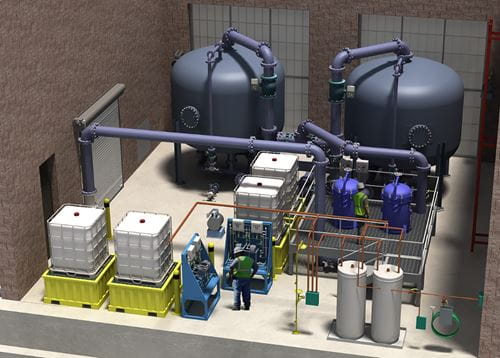CDM Smith and EPOC Introduce Breakthrough PFAS Treatment to North America
BOSTON – A remarkable new separation technology is on its way to the U.S. for the first time, and experts have high hopes for its efficacy in the fight against PFAS. It’s called Surface Activation Foam Fractionation (SAFF®), a portable, containerized, continuous water treatment system that relies on natural processes to separate PFAS from water.
SAFF relies on a natural phenomenon called foam fractionation to separate the PFAS from bodies of water. The natural physiochemistry of PFAS compounds allow them to adhere to fine air bubbles, in this case through a narrow water column. As shown in the animation below, proteins, detergents and fluorosurfactants (like PFAS) can collide with pockets of air, which carry them toward the surface and collectively form bubbles or foam.
CDM Smith researchers identified the potential for foam fractionation to treat PFAS-contaminated water several years ago. EPOC’s breakthrough SAFF system eventually allowed CDM Smith to start testing the power of these unique bubbles at the bench scale in its Bellevue, WA laboratory for several industrial and Department of Defense clients. The results were so encouraging that CDM Smith decided to help deliver this new technology to North America.
“Yes, SAFF involves some fancy engineering and clever design, but at the end of the day, we just use air bubbles to effectively strip PFAS out of solution. And we do this without using adsorbent media, resins or membranes,” said Peter Murphy, managing director at EPOC.
The SAFF system is an important development in PFAS treatment for its versatility, but also for its ability to concentrate PFAS. According to EPOC, the system can reduce about 660,000 gallons of treated water (that’s the amount of an Olympic-size swimming pool) to a single cup of PFAS concentrate. With no extra waste generated, the concentrate would then be ready for destruction technologies, currently in development by CDM Smith.
“The backbone of PFAS is the carbon-fluorine bond, the strongest bond in organic chemistry, making PFAS particularly difficult to break down, said CDM Smith environmental engineer and remediation practice leader Tamzen MacBeth. Promising destruction technologies, like electrochemical oxidation, shown to destroy these “forever” chemicals are also energy intensive. “Treatment trains that first concentrate PFAS using a technology like SAFF® are particularly promising for realizing complete and cost-effective destruction.”
The forthcoming demonstration of this technology will be the first in North America to demonstrate the separate-concentrate-destroy approach, relying on EPOC’s SAFF® unit to generate 5,000-50,000X PFAS-laden foam concentrates for subsequent destruction with CDM Smith’s electrochemical oxidation pilot plant. This will effectively achieve low part-per-trillion discharge criteria. CDM Smith plans to continue similar demonstrations throughout the U.S.
EPOC expects the SAFF unit will be utilized for “plug and play” PFAS remediation in a variety of environments (groundwater, runoff water, lake water and process waters). CDM Smith is aiding in this US deployment by piloting the technology at a variety of project sites.
CDM Smith is a privately owned engineering and construction firm providing legendary client service and smart solutions in water, environment, transportation, energy and facilities. Passionate about our work and invested in each other, we are inspired to think and driven to solve the world's environmental and infrastructure challenges.

Treatment trains that first concentrate PFAS using a technology like SAFF® are particularly promising for realizing complete and cost-effective destruction.




